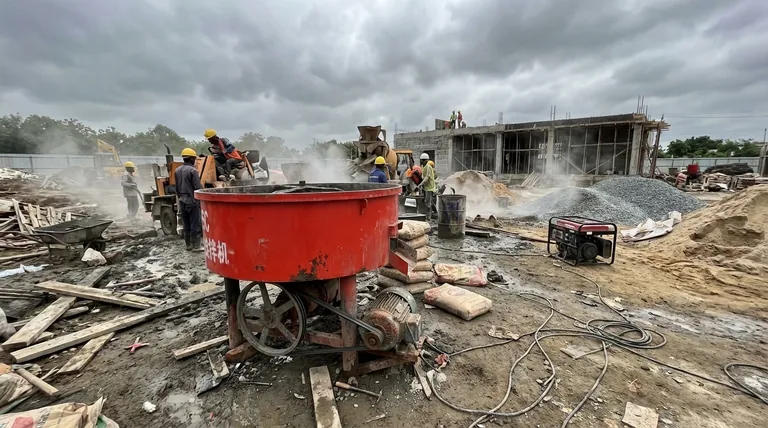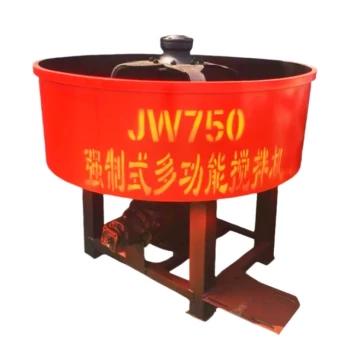While seemingly simple machines, concrete mixers introduce a range of disadvantages that extend beyond their purchase price. The primary drawbacks involve their operational demands, such as needing a power supply and generating significant noise, the ongoing burden of maintenance and repairs, and the inherent risk of producing inconsistent, lower-quality concrete if not managed carefully.
The core disadvantage of a concrete mixer is not the machine itself, but the responsibility it transfers to the operator. It trades the convenience of automated mixing for new challenges in logistics, maintenance, and quality control that are often underestimated.

Operational & Logistical Hurdles
Using a concrete mixer on a job site presents immediate, practical challenges that can impact workflow and efficiency.
Power and Space Requirements
Concrete mixers are not self-contained. They require a reliable power supply, which can be an issue on remote or undeveloped sites.
Furthermore, they occupy a significant physical footprint, which must be accounted for in site planning, especially in constrained urban environments.
Noise Pollution
Mixers, particularly larger models, generate considerable noise. This can be a nuisance to the surrounding area, potentially violating local noise ordinances and requiring hearing protection for operators.
Limited Mobility and Weight
Despite having wheels, concrete mixers are heavy and cumbersome. Moving them across uneven terrain or between different levels of a job site can be a strenuous and time-consuming task, limiting flexibility.
The Financial and Maintenance Burden
The total cost of ownership for a concrete mixer goes far beyond the initial purchase. It's a long-term commitment of time and money.
Beyond the Initial Purchase Price
The sticker price is just the beginning. You must also factor in the costs of power consumption, transportation to and from the site, and the inevitable need for spare parts.
The Reality of Regular Maintenance
Mixers require consistent upkeep to function reliably. Neglecting maintenance quickly leads to costly breakdowns and project delays.
Common failure points include loose mixing blades, overheating motors due to excessive resistance or low voltage, and damaged bearings in the hoist reducer, all of which halt work until repaired.
Sourcing Parts and Support
When a breakdown occurs, finding the right spare parts and qualified support can be a challenge. Opting for a mixer from a manufacturer with a poor support network can turn a minor repair into a major project bottleneck.
Risks to Concrete Quality and Consistency
Perhaps the most critical disadvantage is the potential for the mixer to contribute to poor-quality concrete. The machine does not guarantee a good result on its own.
The Illusion of Automatic Quality
A mixer only tumbles the ingredients you provide. It gives the operator limited control over the final mix quality, which is still dependent on accurate measurement of cement, aggregates, and water.
Batch-to-Batch Inconsistency
Without rigorous procedures, it is very easy to introduce variations between batches. Slight differences in water content or mixing time can lead to noticeable inconsistencies in the strength and appearance of the final cured concrete.
Restricted Flexibility for Custom Mixes
Standard drum mixers are designed for general-purpose recipes. They offer little flexibility for creating specialized or custom mix designs that might be required for high-performance or architectural concrete applications.
Understanding the Trade-offs: Mixer vs. Alternatives
The disadvantages of a mixer are best understood when compared against the alternatives.
Compared to Hand-Mixing
For very small jobs, the setup, cleaning, and maintenance of a mixer can be more trouble than it's worth. Hand-mixing in a wheelbarrow avoids these issues but is physically demanding and unsuitable for anything beyond a few bags.
Compared to Ready-Mix Delivery
For large projects, ready-mix concrete delivered from a plant offers far superior quality control, consistency, and volume. However, it comes with high costs, minimum order requirements, and strict scheduling, making it impractical for smaller or intermittent work.
Making the Right Choice for Your Project
Evaluate your project's specific needs to determine if a mixer's drawbacks are acceptable.
- If your primary focus is small, infrequent DIY repairs: The cost and maintenance of a mixer likely outweigh its benefits; hand-mixing is often more practical.
- If your primary focus is consistent, medium-volume work (e.g., patios, footings): A quality mixer is a valuable tool, provided you commit to rigorous maintenance and proper mixing procedures.
- If your primary focus is large-scale or high-spec projects: The quality control risks of a site mixer are too high; ready-mix delivery is the professional standard.
Ultimately, owning a concrete mixer is a commitment to managing its entire lifecycle, from transport and power to maintenance and quality assurance.
Summary Table:
| Disadvantage Category | Key Challenges |
|---|---|
| Operational & Logistical | Power supply dependency, noise pollution, limited mobility |
| Financial & Maintenance | High total cost of ownership, regular upkeep, parts sourcing difficulties |
| Quality & Consistency | Limited quality control, batch-to-batch inconsistency, inflexibility for custom mixes |
Tired of managing the hidden costs and risks of your concrete mixer?
GARLWAY specializes in providing robust and reliable construction machinery, including concrete mixers designed for durability and ease of maintenance. We support construction companies and contractors globally with quality equipment and accessible parts and support.
Let us help you minimize downtime and maximize your project's efficiency. Contact GARLWAY today to find a concrete solution that works as hard as you do.
Visual Guide

Related Products
- Commercial Construction Mixer Machine for Soil Cement Mixing Concrete
- HZS75 Concrete Batching Plant Cement Mixer Price Concrete Mixer Bunnings Mixing Plant
- HZS180 Ready Mix Concrete Plant for Foundations with Sand and Cement
- Hydraulic Concrete Mixer Machine Cement Mixing Equipment for Mixture Concrete
- Construction Products Concrete Plant Machine Mixing Concrete Mixer
People Also Ask
- What is a concrete mixer and what does it do? Achieve Consistent, High-Strength Concrete
- What is the purpose of a concrete mixer with lift hopper bucket? Automate Material Loading for Maximum Efficiency
- What is the role of concrete mixers in construction? Boost Quality, Efficiency, and Speed
- What is the primary function of a concrete mixer? Ensure Uniform Strength & Durability
- What is a concrete mixer used for? Achieve Consistent, High-Quality Concrete



















